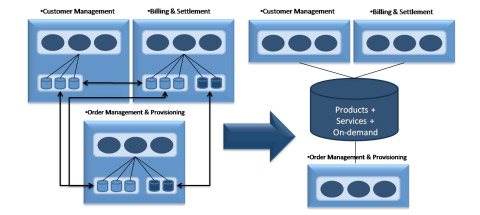
article page
| 1 | 2 | 3 | 4 | 5 | 6 | 7 |that remains distributed in several systems. Conceptually, instead of having to access this data from multiple systems built by different vendors, it is now centralized, as illustrated below:
|
|
Internal to ConceptWave’s solution is metadata application leveraging a SOA bus, along with enabling components that allow rapid configuration of enterprise systems. |
|
 |
|
|

The above illustration implies that distributed data is simply migrated to a centralized location, called an “Enterprise Product catalog”. However, it is impractical to create a single database containing all product and service information in a single master. Therefore, CSPs deploy a number of alternatives:
- Master-Slave configuration: Here, the master database feeds data to “slave” copies within individual systems like CRM or billing.
- Slave-Master configuration: Again, here there are two copies of the data. However, in this approach, if there is a data conflict, the individual systems are considered to contain “true” data sources, so a central data store is a duplicated “slave”. In this approach, the centralized slave can also extend existing catalogs to add new products and services, or to manage a service catalog, while leaving product catalogs distributed.
- Federated configuration: In this approach, the central catalog is only an intermediate view that synchronizes to different product catalogs. Metadata and workflow-driven synchronization drive the coordination of the centralized view.
New Functionality Enabled by a Product Catalog and Unified Sales Management System
ConceptWave’s solution not only resolves the problems described above, but also supports new functionality, as follows:
|
|

Resolving Inconsistencies / Revenue Assurance: In addition to controlling information flow, ConceptWave’s architecture includes functionality to help to resolve inconsistencies. Business rules in ConceptWave’s architecture govern inconsistency resolution, leading to fewer errors and less fallout downstream.
Product Visibility: Whichever approach it selects, with a centralized product catalog in place, a service provider now benefits from a two-way flow of information. Product managers have full visibility into existing products, and can reason about the revenues and margins they can obtain from product launches.
Reduced Fallout through Two-Way Communication and Resource Reservation: Because product managers are able to view existing products and services, as well as the services that support them, they can reserve network resources in advance. This remedies a source of product fulfillment fallout today, which is that the network assets that were expected to be in place during product creation are no longer in place once subscribers start to order it.
Automated GUI generation: Providing automation tools to generate appropriate user interfaces from product catalog and other dynamically available data.
Eligibility Analysis: Providing business rule automation so that prospective customers are offered the right product set (e.g. based on their location, handset capabilities, customer type, rate plan, current promotions, capabilities of the network supplying the customers, etc.).
Offer Management: More complex offers can be managed, and at least some quotations that
article page
| 1 | 2 | 3 | 4 | 5 | 6 | 7 | |
|




